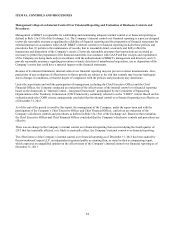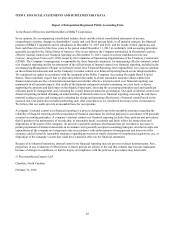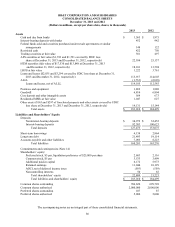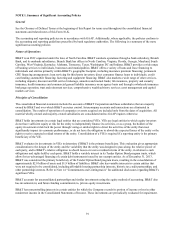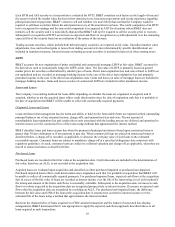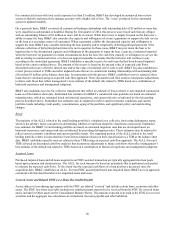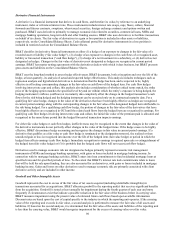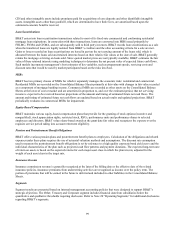BB&T 2013 Annual Report Download - page 94
Download and view the complete annual report
Please find page 94 of the 2013 BB&T annual report below. You can navigate through the pages in the report by either clicking on the pages listed below, or by using the keyword search tool below to find specific information within the annual report.
94
TDRs
Modifications to a borrower’s debt agreement are considered TDRs if a concession is granted for economic or legal reasons
related to a borrower’s financial difficulties that otherwise would not be considered. TDRs are undertaken in order to improve
the likelihood of recovery on the loan and may take the form of modifications made with the stated interest rate lower than
the current market rate for new debt with similar risk, other modifications to the structure of the loan that fall outside of
normal underwriting policies and procedures, or in certain limited circumstances forgiveness of principal or interest.
Modifications of covered loans that are part of a pool accounted for as a single asset are not considered TDRs. TDRs can
involve loans remaining on nonaccrual, moving to nonaccrual, or continuing on accruing status, depending on the individual
facts and circumstances of the borrower. In circumstances where the TDR involves charging off a portion of the loan balance,
BB&T typically classifies these TDRs as nonaccrual.
In connection with commercial TDRs, the decision to maintain a loan that has been restructured on accrual status is based on
a current, well documented credit evaluation of the borrower’s financial condition and prospects for repayment under the
modified terms. This evaluation includes consideration of the borrower’s current capacity to pay, which among other things
may include a review of the borrower’s current financial statements, an analysis of cash flow available to pay debt
obligations, and an evaluation of secondary sources of payment from the client and any guarantors. This evaluation also
includes an evaluation of the borrower’s current willingness to pay, which may include a review of past payment history, an
evaluation of the borrower’s willingness to provide information on a timely basis, and consideration of offers from the
borrower to provide additional collateral or guarantor support. The credit evaluation also reflects consideration of the
borrower’s future capacity and willingness to pay, which may include evaluation of cash flow projections, consideration of
the adequacy of collateral to cover all principal and interest and trends indicating improving profitability and collectability of
receivables.
The evaluation of mortgage and consumer loans includes an evaluation of the client’s debt to income ratio, credit report,
property value, loan vintage, and certain other client-specific factors that impact their ability to make timely principal and
interest payments on the loan.
Nonaccrual commercial TDRs may be returned to accrual status based on a current, well-documented credit evaluation of the
borrower’s financial condition and prospects for repayment under the modified terms. This evaluation must include
consideration of the borrower’s sustained historical repayment performance for a reasonable period (generally a minimum of
six months) prior to the date on which the loan is returned to accrual status. Sustained historical repayment performance for a
reasonable time prior to the TDR may be taken into account. In connection with retail TDRs, a NPL will be returned to
accruing status when current as to principal and interest and upon a sustained historical repayment performance (generally a
minimum of six months).
NPAs
NPAs include NPLs and foreclosed property. Foreclosed property consists of real estate and other assets acquired as a result
of customers’ loan defaults. BB&T’s policies for placing loans on nonaccrual status conform to guidelines prescribed by
bank regulatory authorities. The majority of commercial loans and leases are placed on nonaccrual status when it is probable
that principal or interest is not fully collectible, or generally when principal or interest becomes 90 days past due, whichever
occurs first. Other lending subsidiaries’ loans, which includes both consumer and commercial loans, are placed on nonaccrual
status generally when principal and interest becomes 90 days past due. Direct retail, mortgage and sales finance loans are
placed on nonaccrual status at varying intervals, based on the type of product, generally when principal and interest becomes
between 90 days and 180 days past due. Revolving credit loans are not placed on nonaccrual but are charged off after they
become 150 days past due, with unpaid fees and finance charges reversed against interest income. Covered loans are
considered to be performing due to the application of the expected cash flows method.
Certain loans past due 90 days or more may remain on accrual status if management determines that it does not have concern
over the collectability of principal and interest. Generally, when loans are placed on nonaccrual status, accrued interest
receivable is reversed against interest income in the current period. Interest payments received thereafter are applied as a
reduction to the remaining principal balance as long as concern exists as to the ultimate collection of the principal.
Nonaccrual mortgage loans are accounted for using the cash basis. Loans and leases are generally removed from nonaccrual
status when they become current as to both principal and interest and concern no longer exists as to the collectability of
principal and interest.


